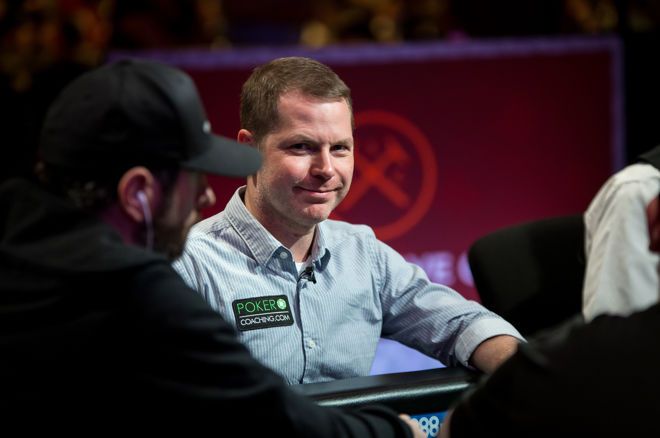What Do You Do w/ a Flush Draw in Multi-Way Pot Short-Stacked in WSOP Main Event?

In the 2019 World Series of Poker (WSOP) Main Event, I found myself in an interesting spot with a flush draw in a multi-way pot. Interesting may not be the right word, as I wound up in a tough spot on the turn.
The hand took place with the blinds at 2,000/4,000/4,000 shortly after I had bluffed off a good portion of my chips, which was highlighted in my last strategy article. A tight-aggressive (TAG) player in the lojack, who was sitting on 292,0000 (73 bb), opened for 8,000 and the player on the button called. I looked down at the 10?9? in the big blind while sitting on a stack of 84,000 (21 bb).
This is certainly a situation where I could shove it all in, I don��t have a problem with that. If the initial raiser was a loose-aggressive player (LAG) I��m pretty sure I��d go in, but from a TAG raiser I��m more inclined to call as I don��t think I have a ton of fold equity against such players.
I do call and the flop comes K?7?2?, which I check. The lojack bets 9,000 and the button calls. This is a spot where the lojack should be betting frequently, even into two players, as they have the range advantage. Once the button calls, he probably has either a pair or a draw, though my hand blocks a bunch of the other obvious flush draws.
You��re going to find that if all of your options are bad, if calling is bad, if raising is bad, then folding is probably right.
We��re not so worried about being against another draw, but what I am worried about is jamming into a king, which either of my opponents could have. In this scenario, I think a call is in order, which is what I do.
The A? turn doesn��t do much for me so I check, as does the lojack. The button then bets 25,000 into the pot of 57,000. You��d think the button wouldn��t have a lot of AxXx in his range, maybe a hand like A?Q? which I��m dead against. If the button has a king, maybe I could jam and have some fold equity, but I think the best options are to either call or fold.
So, am I getting the correct pot odds? Not quite. I��m going to make my flush about 20 percent of the time, but based on the pot odds I need to get there about 25 percent of the time. What about implied odds? If I check the river he��s just going to check it back on a lot of spades, so it��ll be hard to get paid. Plus, as I said I could be dead against a better flush draw.
So, calling isn��t great as I��m not getting the right odds, so I should fold. That��s what I do. You��re going to find that if all of your options are bad, if calling is bad, if raising is bad, then folding is probably right.
We��re just going to fold, move on with our life, and continue playing with our 18 big blind stack. Understand that you are going to experience swings in tournament poker, and a lot of the time those swings are in the downward direction, unfortunately.
For a more thorough breakdown of this hand, check out my thoughts in the following video:
Jonathan Little is a professional poker player and author with over $7,000,000 in live tournament earnings. He writes a weekly educational blog and hosts a podcast at JonathanLittlePoker.com. Sign up to learn poker from Jonathan for free at PokerCoaching.com. You can follow him on Twitter @JonathanLittle.









